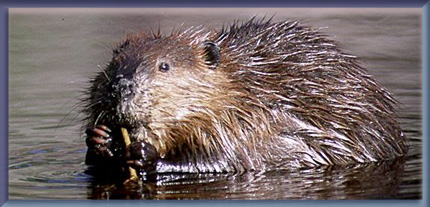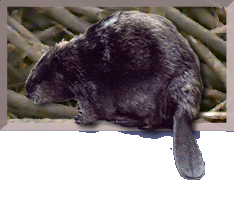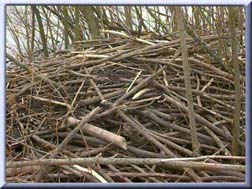Leon M. Lederman Science Education Center
Fermilab Flora and Fauna Virtual Exhibit
Fermilab Flora and Fauna Virtual Exhibit
Beavers - Mother Nature's Engineers

Do beavers live on Fermilab property?
Yes. Several beavers' lodges can be spotted on Fermilab's site. Since beavers, Castor canadensis, are mostly nocturnal animals, they are rarely seen during the day. But a visitor might find evidence of the existence of about twenty resident beavers.

Why are beavers
called "Mother Nature's Engineers"?
Beavers are born knowing how to build lodges and dams. They
stand on their hind legs and cut down trees, while balancing on
their tail. They cut down as many as 200 trees a year, mostly
soft-wood trees such as cotton-woods or willows. This actually
helps the groundcrew of Fermilab to curb the growth of unwanted
trees. The beavers then start their building by holding large
sticks in their mouths and driving them straight into the river
bottoms or ponds. Then almost anything that a beaver can find
goes into the lodges and dams: sticks, grass, rocks, or even old
shoes!
Beavers are fantastic "engineers"! First they build their lodges, which look like six-foot heaps of branches and mud. They gnaw two to five tunnels to be used as entrances and exits. Next, beavers build a dam to raise the water level, which causes water to back up and cover these entrances and exits. The dam is built like a layer cake except that it is held together by mud, not icing, which is smeared on with their paws and noses. Beavers can build a 35-foot long dam in just one week.
What is a beaver family called?
The beaver family is called a colony. A mother and father beaver stay together for their whole lives; and both parents help to raise the babies which are called kits. A female has to wait three and a half months for her kits to be born. While she waits she builds warm, comfortable beds by splitting soft wood into thin chips. Beavers usually have a litter of four kits who live with their parents for two years. The life span of beavers can be up to 19 years.
 What do beavers
look like?
What do beavers
look like?
An adult may grow to be four feet long including the tail and weigh more than 60 pounds. Beavers have a wide, flat tail that looks like a paddle and is covered by scaly skin. It serves as a prop when the beaver sits upright and as a rudder when it swims. The beaver also uses its tail to alert other beavers by smacking it on the water. Beavers have a thick body that is covered by brown, beautiful hair which keeps them very warm. They have small eyes and ears. Their hearing is excellent and they rely on their sharp sense of smell and hearing to alert them to dangers.
Are beavers good swimmers?
Yes. They are champions in the water. They have a flat tail for steering and strong, webbed feet to supply the power. Their large lungs can store lots of air and they can hold their breath for about 10 minutes. Beavers have special muscles that seal their ears while they are diving; and their eyes are protected with a pair of see-through eyelids. Although beavers are fantastic swimmers, they are very awkward on land. Their webbed feet are the size of Ping- Pong paddles and cause them to move very slowly on land.
How do beavers keep their teeth sharp?
All beavers have very sharp, large front teeth that they use
for cutting. Scientists call animals with special
teeth like this rodents. Beavers' front teeth are very special
- they never stop growing! They must chew to trim their teeth
to keep them from getting too long. The more they use their teeth,
the sharper they become. Furry lips close behind their front teeth
to keep water out when they go underwater. They have 20 teeth
in total with chisel-shaped ends.
 Do beavers really
eat wood?
Do beavers really
eat wood?
Yes. Beavers' favorite food is tree bark! In spring, they like to eat juicy shrubs and tree buds. During the fall, they eat more bark than usual to put on more fat for the winter. In fall, they cut down many trees and gnaw them into smaller pieces. These are stored in big underwater piles near their homes. It's like having a pantry! When the ice freezes over the top of their pond, beavers dive down to their food stored underwater. If they run out of food, they just start eating bits of their house!